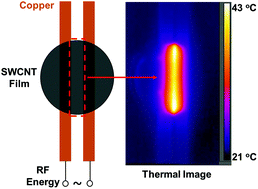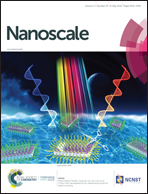Radio frequency heating of metallic and semiconducting single-walled carbon nanotubes†
Abstract
Here we report the effect of metallic (m-) and semiconducting (s-) properties of single-walled carbon nanotubes (SWCNTs) on the response of SWCNT films to radio frequency (RF) heating. We separated high-purity m- and s-SWCNTs from an initial SWCNTs mixture and prepared thin films using vacuum filtration method. The areal density of the films is 9.6 μg cm−2, and the DC conductivities are in the range of 7800–49 000 S m−1. We show rapid and non-contact Joule heating of films using a fringing-field RF applicator, and we observe maximum heating rates in the frequency range of 60–70 MHz. We determine that the more conductive m-SWCNT films reflect RF fields and heat at a maximum rate of 1.51 °C s−1 compared to maximum heating rate of 25.6 °C s−1 for s-SWCNT films. However, m-SWCNTs heat up faster than s-SWCNTs when dispersed in a dielectric medium. Our results confirm the non-monotonic relationship between RF heating rate and conductivity for CNT-based materials such that conductivity is required for heating but high values are correlated with reflections. Our findings also suggest that RF heating could be a possible metric for evaluating film purity because impurities in the films affect the conductivity and thus RF heating rate. We anticipate that RF heating may occur in SWCNT-based electronics and affect their performance.



 Please wait while we load your content...
Please wait while we load your content...
